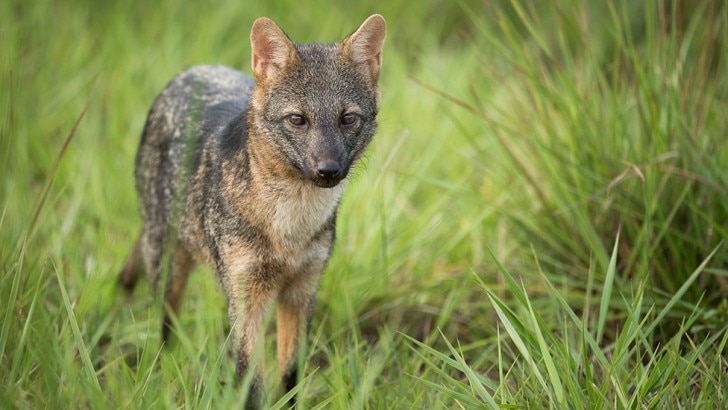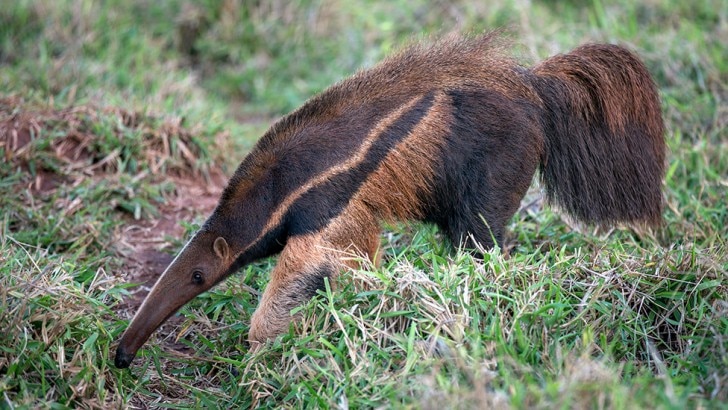BBC Earth newsletter
BBC Earth delivered direct to your inbox
Sign up to receive news, updates and exclusives from BBC Earth and related content from BBC Studios by email.
Animals
Superstitions, those curious beliefs that fortunes can be told or altered by particular events, are present all over the world.
While walking under ladders or breaking mirrors have obvious health and safety implications for us, superstitions concerning animals can impact entire ecosystems.
Many cultures share the belief that owls hooting nearby are harbingers of death, while snakes in the grass signal impending disaster. In the West you’re probably familiar with tales of black cats and across South America, misfortune often travels on four legs too.
For example, the kodkod cat or guiña (Leopardus guigna) is considered a thief and its hen-house raids are said to foretell a death in the family in Chile. It is the smallest species of wild cat on the continent, restricted to the dense forests on the border of Chile and Argentina where it is losing its habitat to logging and human development.

Foxes are the focus of many folk beliefs going back to the Inca Empire. In their folktales, the Inca identify the fox as deceptive and secretive. In modern times, the crab-eating fox (Cerdocyon thous) has been described, in this study of The Role of Mammals in Local Communities Living in Conservation Areas in the Northeast of Brazil, as a “diabolical animal” and associated with bad luck in Brazil. As the name suggests, this canid has been observed eating crabs on floodplains during the wet season, but as an opportunistic omnivore its diet can cause conflict with people.
It is easy to see why people distrust species that threaten their livestock or are perceived as hunting competition. But for some of South America’s most unique and vulnerable species, their unlucky reputation is tied to basic misunderstanding.
Picture a giant, shaggy coated beast with powerful claws, an extremely long snout and a 2-foot tongue. It hunts its prey at night, and wears warning colours. Now call to mind a large grey mammal with a black stripe and bushy tail that hoovers up ants and termites. It rests during the hottest part of the day and is more likely to gallop from danger than confront it.
Both descriptions are of a giant anteater (Myrmecophaga tridactyla), the largest member of the anteater family native to Central and South America. Seeing an animal from such different perspectives has been an essential skill for conservation biologist Mariana Catapani who has been researching attitudes towards giant anteaters in the Brazilian Pantanal for her PhD at the University of Sao Paulo, Brazil.
The Pantanal is the world’s largest tropical wetland area, an extensive mosaic of rainforest, woodland and lower-lying grassland that is inundated in the wet season. Giant anteaters hunt for insects on the savanna-like plains and rest in the marginal forests, but this habitat is being consumed by human development. According to the International Union for the Conservation of Nature (IUCN), the giant anteater is vulnerable in the wild with populations decreasing due to habitat loss for housing, roads and farming. In Mato Grosso do Sul, mid-western Brazil, roadkill is thought to be the second highest threat to giant anteaters. Sadly, research suggests collisions are not always accidental, but determined persecution.

Humans have long been fascinated by these enigmatic animals. In the mythology of the indigenous people of the area giant anteaters are tricksters. When the first specimens appeared in Europe, misconceptions over how they mated fuelled bizarre theories – that all animals were female and mated with their noses - and inspired artists including Salvador Dali. The confusion and mystery around the species persists to this day, alongside a superstition that you will have bad luck if a giant anteater crosses your path.
Discouraging negative attitudes and behaviours towards vulnerable species is essential for conservation, but dealing with superstitions can put conservationists in tricky ethical territory. Simply telling people to abandon their beliefs – some of which go back generations – can damage a complex belief system that connects people to nature. Valuing “rational” scientific knowledge over “irrational” local beliefs also smacks of cultural imperialism.
In a 2017 research paper entitled Fantastic beasts and why to conserve them: animals, magic and biodiversity conservation, Dr George Holmes and colleagues at the University of Leeds, UK, discuss “magical animals” - both mythical animals not recognised by science and existing species believed to have magical properties. The team conclude that “conservation needs to interrogate the interaction of magical animals, extant animals and biodiversity conservation goals.” To achieve this, they recommend approaches such as “multispecies ethnography” which combines studies of animal behaviour with studies of human behaviour, values, culture and beliefs.
To better understand the superstitions around giant anteaters, ecologist Mariana has introduced social science methods to her research and now says she looks at human behaviour as closely as she once studied animal behaviour. Over three years, Mariana interviewed 269 rural people living in proximity to giant anteater habitats. She is now diligently analysing the data and can outline four key elements that drive the superstition.
Firstly, a person is more likely to share the belief if a large number of people in their social group believe the superstition, or an important figure in the community repeats it. Next, if a person knows little about the animal’s behaviour and biology they will fill in the gaps with folk belief. Thirdly, if the animal is considered unattractive: ugly or weird, it is more likely to be distrusted. Finally, if the animal has uncomfortable psychological associations – in this case a phallic snout, secretive nocturnal behaviour and a lack of visible differences between the sexes – it can be associated with ill fortune.
While only a minority will act on the superstition, the consequences can be brutal for giant anteaters. Those that aren’t targeted on roads are tied up and beaten, with a fierce focus on their snout.
The fieldwork suggests that educating local people about the biology of the animals, explaining why they have peculiar appearances and the ‘hidden’ elements of their behaviour, is most effective in encouraging positive attitudes towards them.
To this end, the team developed a children’s book The Incredible Giant Anteater in partnership with Unite for Literacy, Reid Park Zoo, Arizona, US and Greenville Zoo, South Carolina, US. The book has been distributed to local schools in Brazil and explains the animal from tongue to tail including their important role as pest controllers, eating up to 30,000 insects a day, and how females care for their young, carrying them like a backpack.
One thing that is missing from the book is the superstition itself, in order to avoid what is known as confirmation bias – the human tendency to selectively recall and interpret information to affirm prior beliefs. It’s a case of the less said about the species’ unlucky reputation the better.
Superstitions can be hard to shake, as an example from elsewhere on the continent shows. Living in the thickets of Chilean bamboo in the rainforests of the southern Andes is a curious nocturnal creature known as the monito del monte (Dromiciops gliroides) – the little mountain monkey. It isn’t a primate, looks something like a dormouse but is actually a marsupial. It feasts on fruit and plays an essential role in dispersing seeds through the Valdivian rainforest, a unique biodiversity hotspot home to evolutionarily ancient fauna and flora. The species is listed as ‘Near Threatened’ by the IUCN due to habitat loss, but there are references throughout scientific literature to local superstitions putting the animals at risk too.
An early mention is made in Mammals of the World, published in 1968; an anecdotal reference to local people burning down houses because monitos del monte were discovered inside. This was certainly unlucky for the animals and the homeowners, and the dramatic story has been repeated through the years. However it is misleading, according to Dr Francisco E. Fonturbel at the Pontifical Catholic University of Valparaíso, Chile, who has dedicated over a decade to studying the animals and their rainforest home. A former student of his, looking at the socio-economic aspects of wood extraction and its impact on the species, found that people’s beliefs about the little mountain monkey were variable – in some areas it was a bad omen, while other people said it brought good fortune.
The fact that even scientific literature can risk perpetuating negative superstitions shows how influential folk belief can be. Yet the dynamic nature of superstitions also offers some hope. In her studies, Mariana found that the younger interviewees were less likely to share the unlucky superstition about giant anteaters. Similarly, in a 2013 study of local people’s relationships with kodkod cats, the researchers found that children invented their own tales that referenced how the cats are threatened by humans. With a little luck, and plenty of education, negative superstitions will become a thing of the past and we will embrace the good fortune of biodiversity.